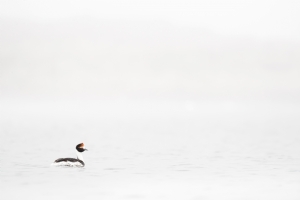GALLERY MONTPHOTO 2021
MontPhoto biennial grant
PROJECT TITLE
Macá Tobiano, un nuevo amanecer
AUTOR/S
Adriana Claudia Sanz
Adriana Sanz, Argentina (1970), has lived since she was a child in Chubut, Patagonia. Master’s degree in environment, she devote herself full time to the care and preservation of the environment. It was from her environmental work that she discovers her passion for nature photography, from where she seeks to aware the public with her photos and raise a greater commitment and protection of the ecosystems and it's living creatures. She is co-founder of the Argentinian Association of Nature Photographers (AFONA) been an active member. She collaborates with her images in conservation organisations and charities, scientific entities, magazines, photographic interviews. She was a member of the jury for the Golden Turtle, FIO-Extremadura, M. Climent Picornell contests. She has been a category winner at the Golden Turtle (2019), NPOTY (2019), honorable mention at Memorial María Luisa (2022) and a finalist in several international competitions. She also gives talks and is a speaker for national and international nature photography festivals
ABSTRACT
According to latest research, it is estimated that the current breeding population of the Hooded grebe (Podiceps gallardoi) is less than 800 individuals. In the last 35 years, the species has declined by 80%. For this reason, it is classified as Critically Threatened globally. It has not bred for two years now due to the absence of the natural conditions that allow it to nest in the southern lagoons where it inhabits. If its extinction has not yet materialised, it is due to the conservation efforts carried out in recent years by popular groups and private civilians determined to save it.
This grebe lives most of its life without touching land. This particularity makes them very dependent on the water bodies and lakes they inhabit. They have not reproduced for more than two years. The main hypothesis for this lack of reproductive rate is the delay in the flowering of the Andean water milfoil (Myriophyllum quitense), a macrophyte (aquatic plant) that they use to build their nests on the water. Also many chicks are lost as a result of depredation from the Kelp gull and the American mink, a species introduced for the fur industry which has colonised the grebe’s breeding area.
Ringing is an essential part of the study to better understand the activity and distribution of the species, taken both during the summer season and the coastal wintering.
It is also essential to add photography to the Hooded grebe Project for documenting the scientific studies in the monitoring of ringed birds, as well as taking record of behaviours, distribution and field actions carried out for the study, conservation and recovery of this unique species in the world.
Rules of the web site | Legal advice | Privacy statement | Cookies policy | Change cookies preferences
Administration | Web design: ATMultimedia.com


.jpg&maxAmplada=350&maxAlsada=200&format=limitat)
.jpg&maxAmplada=350&maxAlsada=200&format=limitat)
.jpg&maxAmplada=350&maxAlsada=200&format=limitat)



